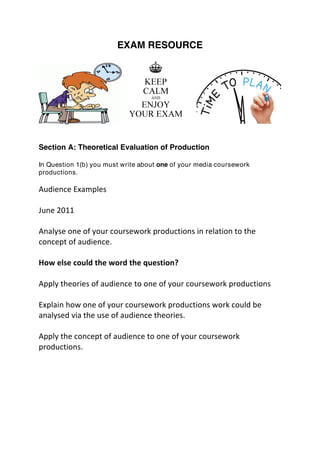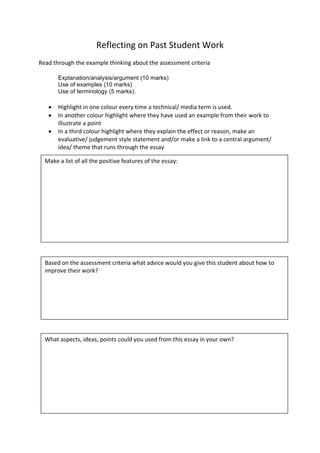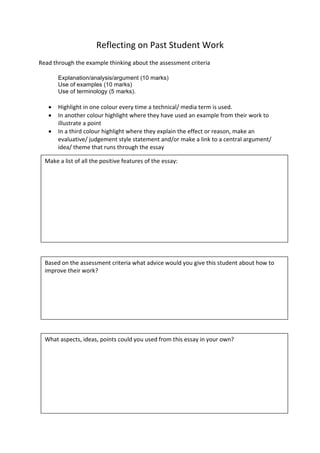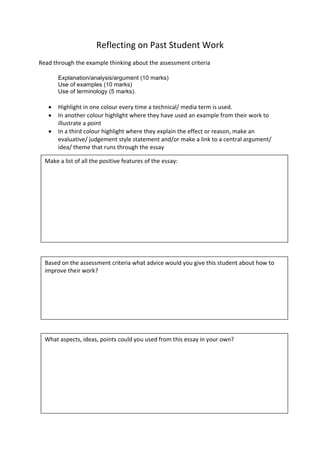This document provides an example response to a past exam question asking students to analyze one of their coursework productions in relation to the concept of audience. The response discusses the student's horror film coursework called "The Sleepover" and analyzes how they took audience into account when creating the film. The response demonstrates understanding of several audience theories (hypodermic needle, uses and gratifications, reception theory) and relates them to choices made in the filmmaking process, such as targeting a specific age range and incorporating feedback. Overall, the summary highlights the student's ability to apply media theories to their own creative work through relevant examples and explanations.

![1 (b) Analyse one of your coursework productions in relation to the concept of
audience. [25]
Candidates will need to choose one production from either Foundation Portfolio or
Advanced Portfolio.
Examiners are reminded that candidates are asked to relate a media production to a
theoretical concept and they are at liberty to either apply the concept to their production or
explain how the concept is not useful in relation to their production.
Level 1 (0-9 marks)
Candidates at this level attempt to relate the production to the basic concept of audience,
with limited clarity. The account may be incomplete or be only partly convincing. Very few, if
any, examples are offered from the chosen production. The answer offers minimal use of
relevant basic conceptual terms.
Some simple ideas have been expressed. There will be some errors of spelling, punctuation
and grammar which will be noticeable and intrusive. Writing may also lack legibility.
Level 2 (10-15 marks)
Candidates offer a mainly descriptive, basic account of how their production can be
understood in the basic theoretical context of audience. A narrow range of examples are
described, of which some are relevant. The answer makes basic use of relevant conceptual
terms.
Some simple ideas have been expressed in an appropriate context. There are likely to be
some errors of spelling, punctuation and grammar of which some may be noticeable and
intrusive.
Level 3 (16-20 marks)
Candidates demonstrate the ability to relate their own creative outcomes to some ideas
about audience drawn from relevant media theory. Some relevant and convincing examples
from the production are offered and these are handled proficiently. The answer makes
proficient use of relevant conceptual language.
Relatively straightforward ideas have been expressed with some clarity and fluency.
Arguments are generally relevant, though may stray from the point of the question. There
will be some errors of spelling, punctuation and grammar but these are unlikely to be
intrusive or obscure meaning.
Level 4 (21-25 marks)
Candidates demonstrate a clear understanding of audience and relevant media theory and
can relate concepts articulately to the production outcome, describing specific elements in
relation to theoretical ideas about how media texts are produced for and received by
audiences in various ways. Candidates offer a broad range of specific, relevant, interesting
and clear examples of how their product can be understood in relation to relevant theories of
audience and reception.
Complex issues have been expressed clearly and fluently using a style of writing appropriate
to the complex subject matter. Sentences and paragraphs, consistently relevant, have been
well structured, using appropriate technical terminology. There may be few, if any, errors of
spelling, punctuation and grammar.](https://image.slidesharecdn.com/audienceessayexamples-180328090417/85/Audience-essay-examples-2-320.jpg)














